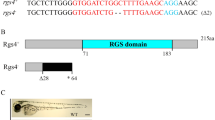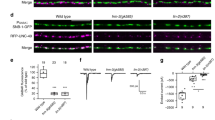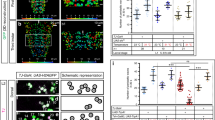Abstract
Ror kinases are a family of orphan receptors with tyrosine kinase activity that are related to muscle specific kinase (MuSK), a receptor tyrosine kinase that assembles acetylcholine receptors at the neuromuscular junction1,2. Although the functions of Ror kinases are unknown, similarities between Ror and MuSK kinases have led to speculation that Ror kinases regulate synaptic development. Here we show that the Caenorhabditis elegans gene cam-1 encodes a member of the Ror kinase family that guides migrating cells and orients the polarity of asymmetric cell divisions and axon outgrowth. We find that tyrosine kinase activity is required for some of the functions of CAM-1, but not for its role in cell migration. CAM-1 is expressed in cells that require its function, and acts cell autonomously in migrating neurons. Overexpression and loss of cam-1 function result in reciprocal cell-migration phenotypes, indicating that levels of CAM-1 influence the final positions of migrating cells. Our results raise the possibility that Ror kinases regulate cell motility and asymmetric cell division in organisms as diverse as nematodes and mammals.
This is a preview of subscription content, access via your institution
Access options
Subscribe to this journal
Receive 51 print issues and online access
$199.00 per year
only $3.90 per issue
Buy this article
- Purchase on Springer Link
- Instant access to full article PDF
Prices may be subject to local taxes which are calculated during checkout





Similar content being viewed by others
References
Valenzuela, D. M. et al. Receptor tyrosine kinase specific for the skeletal muscle lineage: expression in embryonic muscle, at the neuromuscular junction, and after injury. Neuron 15, 573–584 (1995).
DeChiara, T. M. et al. The receptor tyrosine kinase MuSK is required for neuromuscular junction formation in vivo. Cell 85, 501–512 (1996).
Forrester, W. C. & Garriga, G. Genes necessary for C. elegans cell and growth cone migrations. Development 124, 1831–1843 (1997).
Sulston, J. E. & Horvitz, H. R. Post-embryonic cell lineages of the nematode, Caenorhabditis elegans. Dev. Biol. 56, 110–156 (1977).
Podbilewicz, B. & White, J. G. Cell fusions in the developing epithelial of C. elegans. Dev. Biol. 161, 408–424 (1994).
Sulston, J. E., Albertson, D. G. & Thomson, J. N. The Caenorhabditis elegans male: postembryonic development of nongonadal structures. Dev. Biol. 78, 542–576 (1980).
Loer, C. M. & Kenyon, C. J. Serotonin-deficient mutants and male mating behavior in the nematode Caenorhabditis elegans. J. Neurosci. 13, 5407–5417 (1993).
Masiakowski, P. & Carroll, R. D. Anovel family of cell surface receptors with tyrosine kinase-like domain. J. Biol. Chem. 267, 26181–26190 (1992).
Wilson, C., Goberdhan, D. C. & Steller, H. Dror, a potential neurotrophic receptor gene, encodes a Drosophila homolog of the vertebrate Ror family of Trk-related receptor tyrosine kinases. Proc. Natl Acad. Sci. USA 90, 7109–7113 (1993).
Oishi, I. et al. Anovel Drosophila receptor tyrosine kinase expressed specifically in the nervous system. Unique structural features and implication in developmental signaling. J. Biol. Chem. 272, 11916–11923 (1997).
Forrester, W. C., Perens, E., Zallen, J. A. & Garriga, G. Identification of Caenorhabditis elegans genes required for neuronal differentiation and migration. Genetics 148, 151–165 (1998).
Hanks, S. K., Quinn, A. M. & Hunter, T. The protein kinase family: conserved features and deduced phylogeny of the catalytic domains. Science 241, 42–52 (1988).
Henkemeyer, M., West, S. R., Gertler, F. B. & Hoffmann, F. M. Anovel tyrosine kinase independent of Drosophila abl correlates with proper subcellular localization. Cell 63, 949–960 (1990).
Apel, E. D., Glass, D. J., Moscoso, L. M., Yancopoulos, G. D. & Sanes, J. R. Rapsyn is required for MuSK signaling and recruits synaptic components to a MuSK-containing scaffold. Neuron 18, 623–635 (1997).
Herman, R. K. Analysis of genetic mosaics of the nematode Caneorhabditis elegans. Genetics 108, 165–180 (1984).
Hedecock, E. M. & Herman, R. K. The ncl-1 gene and genetic mosaics of Caenorhabditis elegans. Genetics 141, 989–1006 (1995).
Miller, L. M., Waring, D. A. & Kim, S. K. Mosaic analysis using a ncl-1 (+) extrachromosomal array reveals that lin-31 acts in the Pn.p cells during Caenorhabditis elegans vulval development. Genetics 143, 1181–1191 (1996).
Sulston, J. E., Schierenberg, E., White, J. G. & Thomson, J. N. The embryonic cell lineage of the nematode Caenorhabditis elegans. Dev. Biol. 100, 64–119 (1983).
Lauffenburger, D. A. & Horwitz, A. F. Cell migration: a physically integrated molecular process. Cell 84, 359–369 (1996).
Mitchison, T. J. & Cramer, L. P. Actin-based cell motility and cell locomotion. Cell 84, 371–379 (1996).
Hawkins, N. & Garriga, G. Asymmetric cell division: from A to Z. Genes Dev. 12, 3625–3638 (1998).
McIntire, S. L., Garriga, G., White, J., Jacobson, D. & Horvitz, H. R. Genes necessary for directed axonal elongation or fasciculation in C. elegans. Neuron 8, 307–322 (1992).
Mello, C. C., Kramer, J. M., Stinchcomb, D. & Ambros, V. Efficient gene transfer in C. elegans: extrachromosomal maintenance and integration of transforming sequences. EMBO J. 10, 3959–3970 (1991).
Hobert, O. et al. Regulation of interneuron function in the C. elegans thermoregulatory pathway by the ttx-3 LIM homeobox gene. Neuron 19, 345–357 (1997).
Huang, X. On global sequence alignment. Comput. Appl. Biosci. 10, 227–235 (1994).
Acknowledgements
We thank B. Meyer and J. Kaplan for critical reading of this manuscript; K.Kozminski, for microscopy assistance; Y. Kohara for cDNA clones; O. Hobert for the ttx-3-gfp transgene; and C. Walczak for inspiration. This work was supported by a grant from NIH to G.G. and by postdoctoral fellowships from the NIH and the Breast Cancer Research Program of the US Army Medical and Materiel Command to W.C.F.
Author information
Authors and Affiliations
Rights and permissions
About this article
Cite this article
Forrester, W., Dell, M., Perens, E. et al. A C. elegans Ror receptor tyrosine kinase regulates cell motility and asymmetric cell division. Nature 400, 881–885 (1999). https://doi.org/10.1038/23722
Received:
Accepted:
Issue Date:
DOI: https://doi.org/10.1038/23722
This article is cited by
-
Association of baseline ROR1 and ROR2 gene expression with clinical outcomes in the I-SPY2 neoadjuvant breast cancer trial
Breast Cancer Research and Treatment (2023)
-
Wnt5a induces ROR1 to recruit cortactin to promote breast-cancer migration and metastasis
npj Breast Cancer (2019)
-
Wnt5a causes ROR1 to complex and activate cortactin to enhance migration of chronic lymphocytic leukemia cells
Leukemia (2019)
-
Wnt5a induces ROR1 to complex with HS1 to enhance migration of chronic lymphocytic leukemia cells
Leukemia (2017)
-
Dishevelled proteins are significantly upregulated in chronic lymphocytic leukaemia
Tumor Biology (2016)
Comments
By submitting a comment you agree to abide by our Terms and Community Guidelines. If you find something abusive or that does not comply with our terms or guidelines please flag it as inappropriate.



